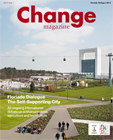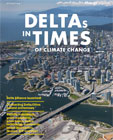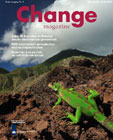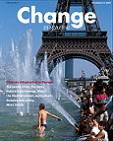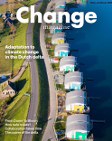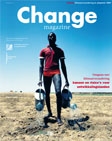Biodiversity on Bonaire, St. Eustatius and Saba
A Change Magazine special
The Dutch Caribbean, a name that ignites the imagination. In October 2010 the BES islands, Bonaire, St Eustatius and Saba, acquired the status of special municipalities of the Netherlands, and the former Netherlands Antilles ceased to exist.
The islands are home to priceless ecological treasures, both under water and on land: turtles, lobsters, whales, dolphins, coral, flamingo's, and a seemingly endless list of tropical plant species. In the year of biodiversity, the Netherlands has therefore acquired a greater responsibility for natures riches.
This edition of Change magazine provides a glimpse into the wealth of biological riches that the BES islands possess. It also highlights the opportunities and threats that humans and wildlife face in this new piece of the Netherlands.
Features
Three caribbean municipalities
 Sea turtles, flamingo's and coral... in the Netherlands! On 10 october 2010 Bonaire, St. Eustatius and Saba became part of the Netherlands. Where are these municipalities situated and how do they look like?
Sea turtles, flamingo's and coral... in the Netherlands! On 10 october 2010 Bonaire, St. Eustatius and Saba became part of the Netherlands. Where are these municipalities situated and how do they look like?
Nature in all its diversity
 From cloud forest to coral pillars. Each of the three islands not only has its own culture and language but the differences in their natural environments are as big as those between the Wadden Sea and the hills of Limburg.
From cloud forest to coral pillars. Each of the three islands not only has its own culture and language but the differences in their natural environments are as big as those between the Wadden Sea and the hills of Limburg.
How the Netherlands protects its coral
 How should the Netherlands treat its scenic marine beauty, with its hundred of kilometres of coral where fishermen earn a living? The Exclusive Economic Zone serves as both an economic tool and a way of protecting biodiversity.
How should the Netherlands treat its scenic marine beauty, with its hundred of kilometres of coral where fishermen earn a living? The Exclusive Economic Zone serves as both an economic tool and a way of protecting biodiversity.
Exclusive Economic Zone (EEZ)
 Ships that drop anchor in protected coral reefs have been forewarned: with introduction of the EEZ the Coast Guard now patrols a larger area and is more effective in catching offenders.
Ships that drop anchor in protected coral reefs have been forewarned: with introduction of the EEZ the Coast Guard now patrols a larger area and is more effective in catching offenders.
Heaven can wait, this is paradise
 Opinion Ruud Koornstra
Opinion Ruud Koornstra
Entrepreneur in sustainability Ruud Koornstra talks about sustainability on 'his' Bonaire. "Bonaire can become a textbook example of sustainability"
From heather to mangrove and coral
 A mangrove forest is not the first thing that comes to mind when you think of Dutch nature reserves. And yet, Dutch conservation organizations will soon be concerned with exotic landscapes and ecosystems.
A mangrove forest is not the first thing that comes to mind when you think of Dutch nature reserves. And yet, Dutch conservation organizations will soon be concerned with exotic landscapes and ecosystems.
A new chapter for Saba, Statia and Bonaire
 On 10-10-2010 Saba, St Eustatius and Bonaire received a new status that ties them more closely to the Netherlands. What does that mean for the islands, their inhabitants and their ties to the Netherlands?
On 10-10-2010 Saba, St Eustatius and Bonaire received a new status that ties them more closely to the Netherlands. What does that mean for the islands, their inhabitants and their ties to the Netherlands?
St. Eustatius, a diamond in the rough
 St Eustatius, affectionately called Statia, is just what the brochure claims: 'The Caribbean's hidden treasure'. With such incredibly diverse nature, the Netherlands has gained a diamond in the rough.
St Eustatius, affectionately called Statia, is just what the brochure claims: 'The Caribbean's hidden treasure'. With such incredibly diverse nature, the Netherlands has gained a diamond in the rough.
From self-regulation to conventions
 Fishermen on the islands awaiting developments
Fishermen on the islands awaiting developments
Fishing is an source of income for the islands but the sector is also in need of regulations. The fishermen are learning to cope with the new reality.
International treaties protect all species
 The nature is spectacular, but also vulnerable, and many of the islands' plants and animals can be sold for big money on the market. International agreements have been made to protect these species and ecosystems.
The nature is spectacular, but also vulnerable, and many of the islands' plants and animals can be sold for big money on the market. International agreements have been made to protect these species and ecosystems.
The same dance to different rhythms
 Lt Governor Glenn Thodé in discussion with the former Kingdom Representative and current Minister of Social Affairs Henk Kamp about opportunities, respect and progress.
Lt Governor Glenn Thodé in discussion with the former Kingdom Representative and current Minister of Social Affairs Henk Kamp about opportunities, respect and progress.
Saba, the unspoiled Queen
 An emerald of 13 square kilometres, a green speck in an aquamarine sea. The Unspoiled Queen is still untouched by the 21st century. It is not inhabited, but it is populated. And this means it is high time for regulation.
An emerald of 13 square kilometres, a green speck in an aquamarine sea. The Unspoiled Queen is still untouched by the 21st century. It is not inhabited, but it is populated. And this means it is high time for regulation.
 Synergos Communication
Synergos Communication
